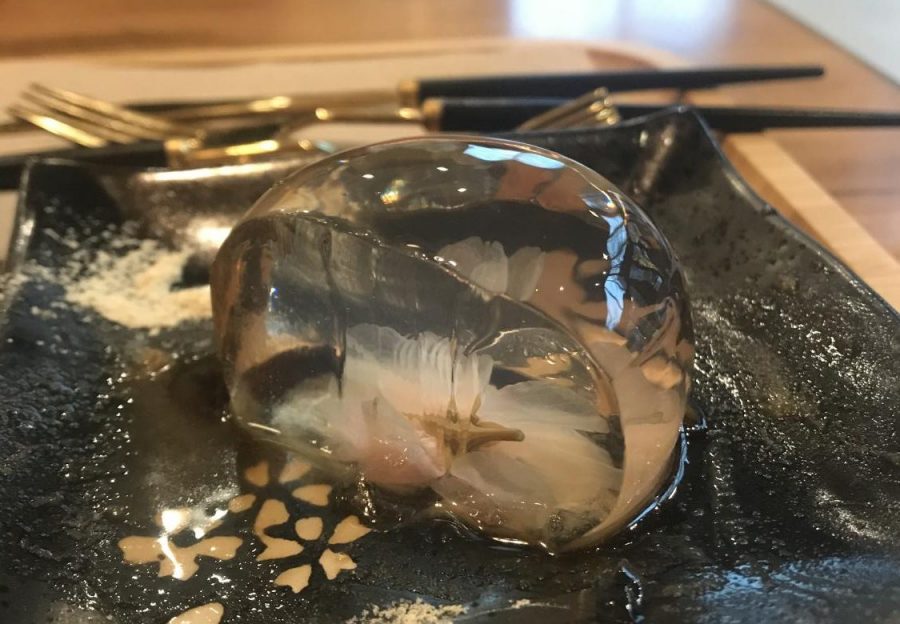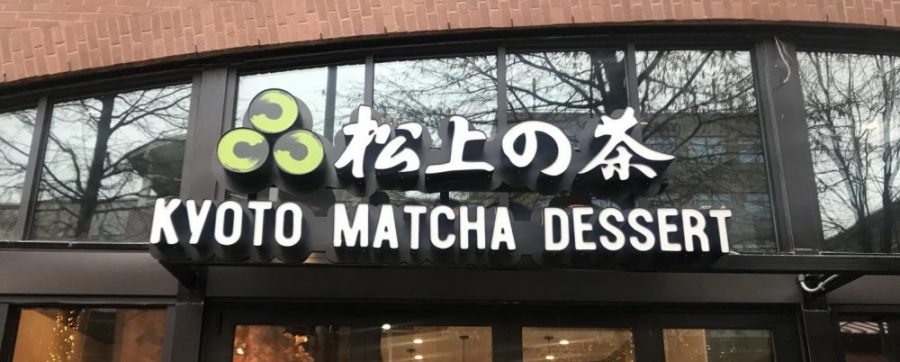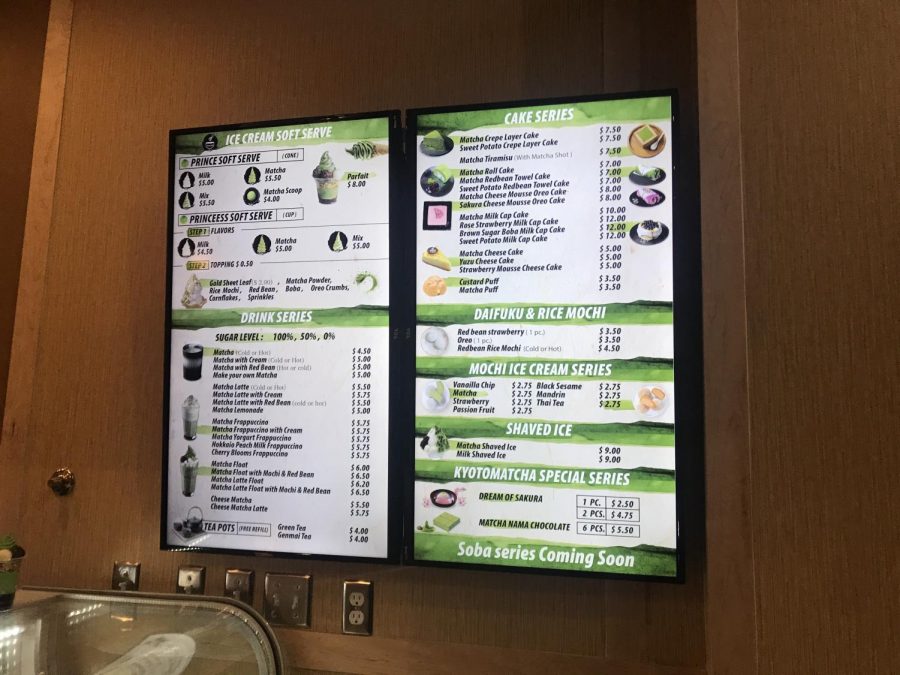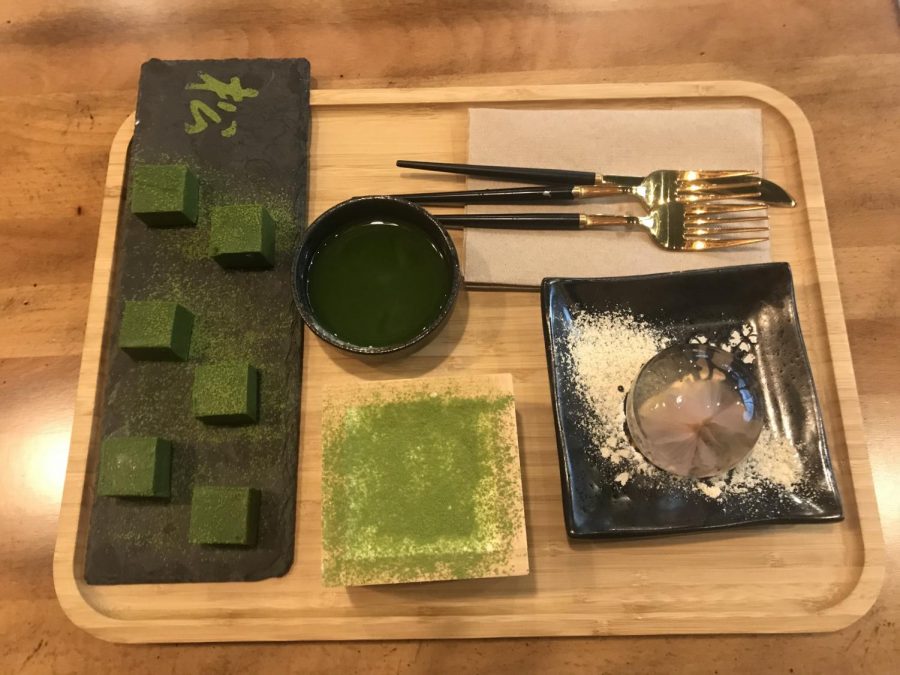Your donation will support the student journalists of The Tide, Richard Montgomery High School's student newspaper. Your contribution will allow us to purchase equipment and cover our annual website hosting costs.
Kyoto Matcha: Taste and look fail to match-a up
December 10, 2019
The Dream of Sakura, part of the Kyotomatcha Special Series, looks far better than it tastes.
Ever since the Mellow Mushroom across from Rockville Memorial Library closed down in September 2018, I’ve waited with bated breath for the “coming soon” signs to finally be replaced with “now open.” That day, at least for Kyoto Matcha Dessert, has arrived at long last. But don’t get too excited over the woven lanterns lining the ceiling or intricately layered cake slices—Kyoto Matcha churns out delicacies with all style, no substance. As much as I wanted to love and support the newest addition to Rockville Town Center’s seemingly endless list of Asian restaurants, Kyoto Matcha is going to need a lot more flavor to earn its place in the heart of Rockville.
Entering the shop gives me high hopes—the exterior isn’t much to look at, but then again, the same goes for just about any neon-lettered, bland brick restaurant in RTC, even the big names like Starbucks and Panera Bread. The decorations inside are distinctly Asian-inspired, with a foundation of white wood across the walls and floor, even spanning the ceiling in long slats adorned with pale pink—clearly fake, but nonetheless beautiful—cherry blossoms. Two styles of lanterns hang from the ceiling, and at least eight miniature porcelain figures of Japanese women watched from the walls, just hanging out next to the good old food service facility license.
The only other occupants of the shop are the young Asian woman sitting in the back corner on her laptop and the young Asian woman working at the counter. The latter is very polite as I order from the “Kyotomatcha Special Series” at the bottom of the menu: one piece of Dream of Sakura for $2.50, and six pieces of Matcha Nama Chocolate for $5.50. I also snag a piece of matcha tiramisu with something called a “matcha shot” for $7.50; the prices for their cakes are somewhat less forgiving than those of their supposed specialties. A cursory glance in the glass case reassures me that at the very least, I will be leaving with something Instagrammable.
Almost immediately, the waitress emerges from the back with a tray of the same whitewashed wood as the walls, bearing desserts identical to those displayed in the case. She explains that the green liquid in the bowl is the matcha shot, intended for customers to drink—I wonder how else other customers have used it, forcing her to specify. I’m personally more thrown off by the matcha tiramisu, which just appears to be a wooden box with matcha powder dusted over it; it’s not until I dig my fork in that the tightly packed tiramisu gives way to reveal the layers of thick cream and—you guessed it!—more matcha powder. At the very least, this is not a false-advertising sort of situation. The cream and cake combined create the classic tiramisu consistency, if a bit on the thicker side, but their taste doesn’t quite mix with the layers of matcha, and when I get to the dark green layer coating the bottom of the wooden box, I can’t help but think of seaweed, which certainly isn’t helping. The matcha shot, though, tastes much more authentic than any matcha I’ve had before in its lack of sweetness, and helps cut through some of the thickness of the tiramisu. The greatest annoyance is the box itself, which makes it far too difficult to scrape off the crumbs stuck to the bottom and which I imagine is a real pain to have to wash regularly.
I turn to the Dream of Sakura: a drop of rain caught on the petal of a flower, only in reverse. My knife cuts all too easily through the shimmering gelatin, and as I chew I realize I have stumbled upon the strange middle ground between melt-in-your-mouth-soft and a satisfying gummy texture, in which you must still chew but your teeth are met with so little resistance that you wonder if you’re really consuming anything at all. The flavor seems to come from the brownish sauce under the bubble, which somehow tastes like pure sugar and pure emptiness at the same time. The flower in the middle, freed from its careful suspension, is another contradiction, both soggy and unnervingly crunchy. I personally err here by taking another sip of the matcha shot, which now seems terribly bitter by comparison.
My last hope is the Matcha Nama Chocolate, six green cubes dusted with matcha powder. Hard to go wrong with chocolate, I think as I bite into one, and the taste holds true, with a pleasant, unremarkable hint of matcha aftertaste. In comparison to the Dream of Sakura, the chocolate was a real jaw workout; I personally recommend pairing the chocolate with the matcha shot, or at least with some water.
Kyoto Matcha certainly lives up to its mission to promote “Matcha culture,” and I give it points for embracing flavors that may seem unconventional to the Western palate. However, the flavors don’t seem like they’ve been thought through, either creating desserts with little to no flavor at all or creating pairings of individually delicious flavors that leaves a strange aftertaste. And in all cases, there is a clear sense of fashion, whether the aesthetic is a shiny bubble or a quirky wooden box, over function. Though the complete domesticity of the scene admittedly puts me at ease, I wonder how much of the design has to do with Kyoto Matcha’s call to “let tea return to the forest,” and how much is an attempt to spoonfeed a digestible version of “oriental” culture to Westerners, bits and pieces of stereotypes placed just so, leaving customers feeling proud for venturing outside their comfort zones without ever leaving them. Even disregarding any possible pandering, these walls hold the potential for something great, which their quaint decor is not decidedly not. There are no real traces of forest left in this shop, only tamed garden blossoms and wood hewn and bleached from once-wild trees.
I truly did enjoy my time within Kyoto Matcha’s cozy walls, but as business picks up, there are changes to be made, most importantly with the taste of the food, and possibly a redecoration to fit the style of the food instead of vaguely hinting at Japanese culture. Diehard matcha fans, you might still eat your hearts out. For those interested in a gateway into matcha… may I suggest a green tea Kit Kat?



